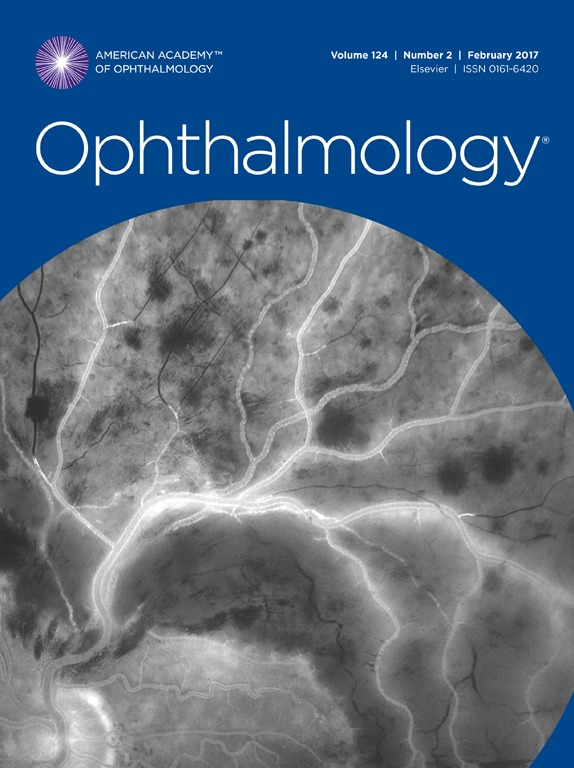基于人口的研究中近视与眼部疾病的正相关和负相关。
IF 13.1
1区 医学
Q1 OPHTHALMOLOGY
引用次数: 0
摘要
目的:近视的发病率以及近视性黄斑变性和近视相关视神经病变导致的视力损害在全球范围内显著增加。我们评估了近视与其他眼部疾病的发病率是否存在正相关或负相关:设计:在俄罗斯、中国和印度进行的基于人口的研究:俄罗斯乌拉尔眼科与医学研究(UEMS)和北京眼科研究(BES)分别包括 5899 人和 4439 人(年龄均在 40 岁以上),印度中部眼科与医学研究(CIEMS)包括 4711 人,年龄均在 30 岁以上。这些研究分别在俄罗斯巴什科尔托斯坦、印度那格浦尔和中国北京的农村和城市地区进行:方法:参与者接受了一系列眼科和一般医学检查:主要结果指标:作为近视替代指标的轴长,糖尿病视网膜病变(DR)、老年性黄斑变性(AMD)、闭角型青光眼(ACG)和开角型青光眼(OAG)的患病率:在 UEMS 中,DR 患病率(OR:0.73;95%CI:0.56,0.96)、AMD 患病率(OR:0.85;95%CI:0.74,0.98)和 ACG 患病率(OR:0.72;95%CI:0.55,0.95)随着轴长的增加而降低,而 OAG 患病率(OR:1.65;95%CI:1.45,1.88)随着轴长的增加而增加。在 CIEMS 中,较低的 AMD 患病率(OR:0.81;95%CI:0.69,0.95)和较低的 ACG 患病率(OR:0.55;95%CI:0.36,0.83)以及较高的 OAG 患病率(OR:1.45;95%CI:1.15,1.83)与较长的轴向长度有关。在 CIEMS 中,DR 患病率(0.33%;95%CI:0.16,0.50)太低,无法进行统计分析。在 BES 中,DR 患病率(OR:0.64;95%CI:0.50,0.81)和 10 年发病率(OR:0.48;95%CI:0.33,0.71)以及 AMD 患病率(OR:0.83;95%CI:0.77,0.89)和 5 年发病率(OR:0.996;95%CI:0.993,0.999)降低,而OAG的患病率(OR:1.35;95%CI:1.17,1.56)和10年发病率(OR:1.40;95%CI:1.22,1.61)则随着轴长的增加而增加。在所有三项研究中,OAG发病率较高与轴长之间的关系是非线性的,在中度近视范围内略有增加,而在高度近视范围内则急剧增加:近视与较低的 DR、AMD 和 ACG 患病率以及较低的 DR 和 AMD 发病率有关,而高度近视比中度近视与较高的 OAG 患病率和发病率有关。未来的研究可能会评估近视,尤其是中度近视,与近视相关的优势,即较低的DR、AMD和ACG发病率,是否会超过增加的OAG和其他近视相关疾病的风险。本文章由计算机程序翻译,如有差异,请以英文原文为准。
Positive and Negative Associations of Myopia with Ocular Diseases in Population-Based Studies
Purpose
Prevalence of myopia and vision impairment due to myopic macular degeneration and myopia-related optic neuropathies have markedly increased worldwide. We evaluated whether myopia is associated with other ocular disorders.
Design
Population-based studies conducted in Russia, China, and India.
Participants
The Russian Ural Eye and Medical Study (UEMS) and the Beijing Eye Study (BES) included 5899 individuals and 4439 individuals (all aged 40+ years), respectively, and the Central India Eye and Medical Study (CIEMS) consisted of 4711 individuals aged 30+ years. The studies were conducted in rural and urban regions in Bashkortostan/Russia, Nagpur/India, and Beijing/China.
Methods
The participants underwent a series of ophthalmological and general medical examinations.
Main Outcome Measures
Axial length as a surrogate for myopia and prevalence of diabetic retinopathy (DR), age-related macular degeneration (AMD), angle-closure glaucoma (ACG), and open-angle glaucoma (OAG).
Results
In the UEMS, DR prevalence (odds ratio [OR], 0.73), AMD prevalence (OR, 0.85), and ACG prevalence (OR, 0.72) decreased, and OAG prevalence (OR, 1.65) increased with longer axial length in multivariable analyses. In the CIEMS, lower AMD prevalence (OR, 0.81) and lower ACG prevalence (OR, 0.55), and higher OAG prevalence (OR, 1.45) were associated with longer axial length. Diabetic retinopathy prevalence (0.33%) was too low for statistical analysis in the CIEMS. In the BES, prevalence (OR, 0.64) and 10-year incidence of DR (OR, 0.48) and prevalence (OR, 0.83) and 5-year incidence of AMD (OR, 0.996) decreased, and prevalence (OR, 1.35) and 10-year incidence of OAG (OR, 1.40) increased with longer axial length. In all 3 studies, the association between higher OAG prevalence and longer axial length was nonlinear with a slight increase for the moderate myopia range and a steep increase in the highly myopic range.
Conclusions
Myopia is associated with a lower prevalence of DR, AMD, and ACG and a lower incidence of DR and AMD, whereas high myopia more than moderate myopia is associated with a higher prevalence and incidence of OAG. Future studies may assess whether in myopia (in particular, in moderate myopia), the myopia-related advantages, that is, lower prevalence of DR, AMD, and ACG, may outweigh the increased risks for OAG and other myopia-related disorders.
Financial Disclosure(s)
Proprietary or commercial disclosure may be found after the references.
求助全文
通过发布文献求助,成功后即可免费获取论文全文。
去求助
来源期刊

Ophthalmology
医学-眼科学
CiteScore
22.30
自引率
3.60%
发文量
412
审稿时长
18 days
期刊介绍:
The journal Ophthalmology, from the American Academy of Ophthalmology, contributes to society by publishing research in clinical and basic science related to vision.It upholds excellence through unbiased peer-review, fostering innovation, promoting discovery, and encouraging lifelong learning.
 求助内容:
求助内容: 应助结果提醒方式:
应助结果提醒方式:


